-
 This game by Gottlieb is a very challenging design. It was invented by Ed Krynski and artwork was drawn by Gordon Morrison. This game has 10 drop targets lined up the left side of the playfield. If one target is hit, one scores 500 points. If, however, you’re skillful enough to hit a blue and white target at the same time, 5,000 points are awarded. Completing the sequence 1-9 lights the special at the bottom left rollover as well as lights the drop targets to score a special if all the targets are dropped. The player had to be wary when trying to freeze the ball on the right flipper, as one could lose the ball up the right guide rail (which has an opening in it the size of a ball). This playfield design was used a few times by Gottlieb, as it was a successful design (games like Gottlieb 300, for example, a bowling themed game). Scoring games by core were another option.
This game by Gottlieb is a very challenging design. It was invented by Ed Krynski and artwork was drawn by Gordon Morrison. This game has 10 drop targets lined up the left side of the playfield. If one target is hit, one scores 500 points. If, however, you’re skillful enough to hit a blue and white target at the same time, 5,000 points are awarded. Completing the sequence 1-9 lights the special at the bottom left rollover as well as lights the drop targets to score a special if all the targets are dropped. The player had to be wary when trying to freeze the ball on the right flipper, as one could lose the ball up the right guide rail (which has an opening in it the size of a ball). This playfield design was used a few times by Gottlieb, as it was a successful design (games like Gottlieb 300, for example, a bowling themed game). Scoring games by core were another option. -
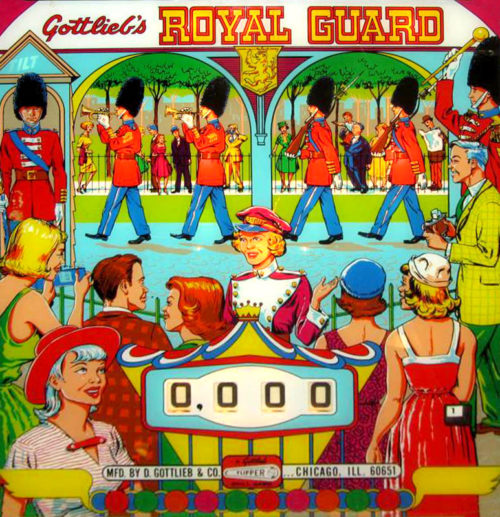
-
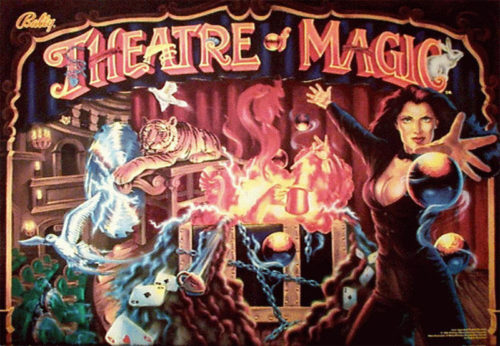 John Popodiuk designed this magical game with artwork penned by Linda Deal. 6,600 units were manufactured. This game is always in the top 10 machines in collectibility. The magic trunk is the centerpiece of the playfield. Its multifunctional sides rotate according to the storyline of the machine at the time. Eight illusions are to be collected in a typical game. This is one of four requirements needed to complete the grand finale stage of the game. Advancing the clock to midnight by shooting the right-side lane 12 times or hitting the captive ball completes this feature. Multiball must be made at the trunk to complete the third part of the puzzle. The last issue is completing the word “theater” by certain ramp shots. Grand finale is tough to achieve but a neat show awaits you. Vanish is another feature that makes a ball disappear when shot up the left-side ramp; the ball reappears when the right ramp is made.
John Popodiuk designed this magical game with artwork penned by Linda Deal. 6,600 units were manufactured. This game is always in the top 10 machines in collectibility. The magic trunk is the centerpiece of the playfield. Its multifunctional sides rotate according to the storyline of the machine at the time. Eight illusions are to be collected in a typical game. This is one of four requirements needed to complete the grand finale stage of the game. Advancing the clock to midnight by shooting the right-side lane 12 times or hitting the captive ball completes this feature. Multiball must be made at the trunk to complete the third part of the puzzle. The last issue is completing the word “theater” by certain ramp shots. Grand finale is tough to achieve but a neat show awaits you. Vanish is another feature that makes a ball disappear when shot up the left-side ramp; the ball reappears when the right ramp is made. -
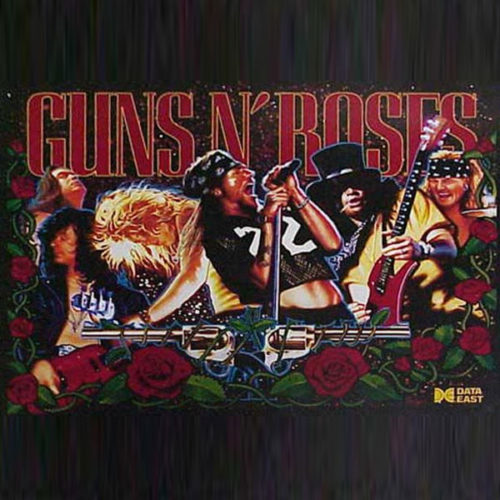
-
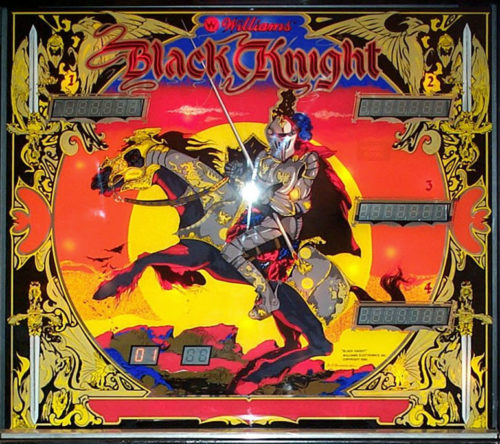 This game is another breakthru game by Williams. 13,075 units were made. Steve Ritchie designed the game and Tony Ramunni did the art package. Larry Demar programmed the game. Black Knight invented the “magna save” feature which is activated by the second flipper buttons on the side of the cabinet. When active, timing is critical. By activating this feature, the ball, which was about to drain down the side drains, is magically transported to the ball guide lane back to the flipper for continued play. This game also incorporated the “bonus ball” feature if more than one player was playing the game. The person with the highest score is awarded at the end of the game with a bonus round, which is timed to try and pop a game. Finally, this game is the first game to have a two-level playfield. Steve Ritchie, the designer, used his voice as the Black Knight.
This game is another breakthru game by Williams. 13,075 units were made. Steve Ritchie designed the game and Tony Ramunni did the art package. Larry Demar programmed the game. Black Knight invented the “magna save” feature which is activated by the second flipper buttons on the side of the cabinet. When active, timing is critical. By activating this feature, the ball, which was about to drain down the side drains, is magically transported to the ball guide lane back to the flipper for continued play. This game also incorporated the “bonus ball” feature if more than one player was playing the game. The person with the highest score is awarded at the end of the game with a bonus round, which is timed to try and pop a game. Finally, this game is the first game to have a two-level playfield. Steve Ritchie, the designer, used his voice as the Black Knight. -
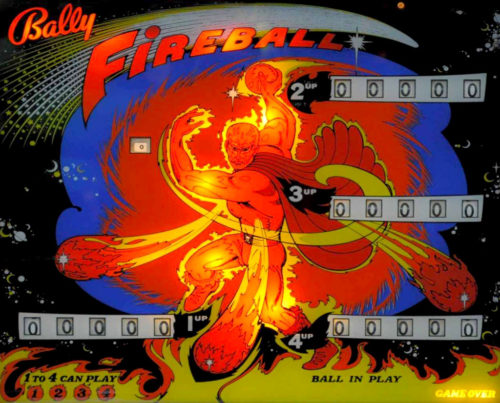 This is it. The ultimate collectible game of the ‘70s according to the literature. Bally put together Ted Zale and Dave “Mad Dog” Christianson to design the game. Production run was 3,815 units. Many firsts here. The whirlwind spinning disk was a first to throw off the ball once rolled upon. A messenger ball (captive ball) was a variation on a theme. The art package is truly amazing. A lower-left kick-back kicker, when activated, returns your ball to play. A free ball gate returns your ball to the plunger. “Zipperflippers”, a first, closes the gap between the flippers, when activated, preventing the loss of the ball thru the center drain until turned off. Once you lock two balls in the “odin” and “wotan” kickout holes, then hit “release messenger balls”, three balls are in play. No jackpot in multiball in this game was developed. You just had a period of high scoring and pinball chaos to contend with until you lost the first two balls in play.
This is it. The ultimate collectible game of the ‘70s according to the literature. Bally put together Ted Zale and Dave “Mad Dog” Christianson to design the game. Production run was 3,815 units. Many firsts here. The whirlwind spinning disk was a first to throw off the ball once rolled upon. A messenger ball (captive ball) was a variation on a theme. The art package is truly amazing. A lower-left kick-back kicker, when activated, returns your ball to play. A free ball gate returns your ball to the plunger. “Zipperflippers”, a first, closes the gap between the flippers, when activated, preventing the loss of the ball thru the center drain until turned off. Once you lock two balls in the “odin” and “wotan” kickout holes, then hit “release messenger balls”, three balls are in play. No jackpot in multiball in this game was developed. You just had a period of high scoring and pinball chaos to contend with until you lost the first two balls in play. -
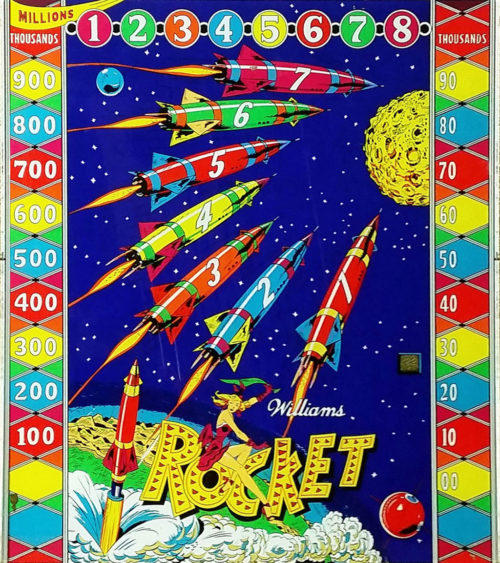 This unique woodrail game was screwed together in November of the year following the success of a Gottlieb space theme called Rocketship. Harry Williams designed the playfield and game rules while George Molentin inked the artwork. The object of the game is to score at least three rockets on the backglass in order. Doing so awards a replay. This is not an easy task as most of the rockets are “selected” at the top of the machine’s playfield and, even though you may have had a countdown going on a desired numbered rocket to complete this feat, the next ball will most likely change the selected rocket in your countdown sequence! To spot a rocket, you must count down five levels to light the fire bumpers. Hitting one of these spots your actively selected rocket. More replays are yours if you can achieve four, five, six, or seven rockets in order, an extremely rare feat. Score is also another way to score replays. A very challenging playfield for sure, between trying to change your selected rocket and the high-side drain exits take some time to master.
This unique woodrail game was screwed together in November of the year following the success of a Gottlieb space theme called Rocketship. Harry Williams designed the playfield and game rules while George Molentin inked the artwork. The object of the game is to score at least three rockets on the backglass in order. Doing so awards a replay. This is not an easy task as most of the rockets are “selected” at the top of the machine’s playfield and, even though you may have had a countdown going on a desired numbered rocket to complete this feat, the next ball will most likely change the selected rocket in your countdown sequence! To spot a rocket, you must count down five levels to light the fire bumpers. Hitting one of these spots your actively selected rocket. More replays are yours if you can achieve four, five, six, or seven rockets in order, an extremely rare feat. Score is also another way to score replays. A very challenging playfield for sure, between trying to change your selected rocket and the high-side drain exits take some time to master. -
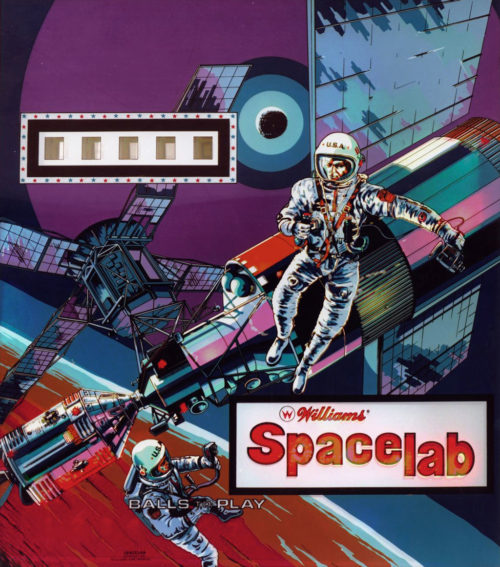
-
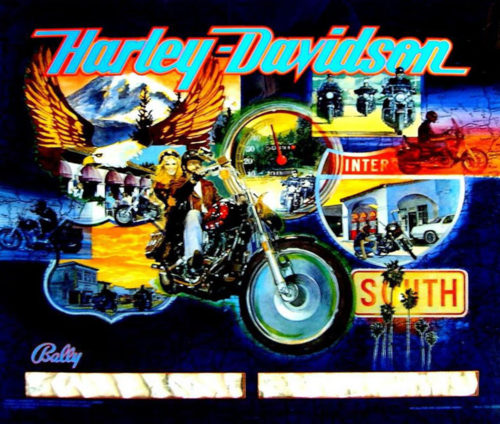
-
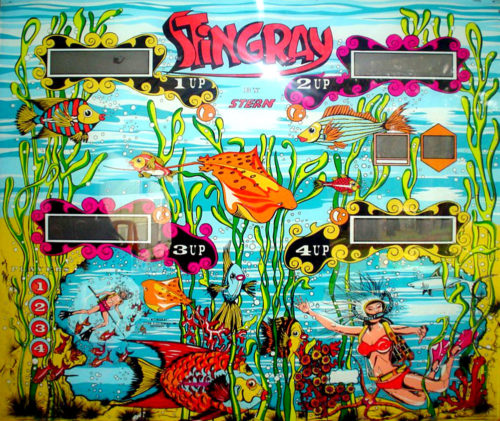 Here’s a 1977 Stern ‘Pinball’. This was Stern’s first solid state machine and marked the beginning of a long and interesting history for the company. Designed by Mike Kubin, it’s a fast game that has some wicked out-lanes and very quick ball times. There are no mini-posts above the out-lane guides which make controlling the ball near the out-lanes very difficult. Stingray, the game made by Stern following ‘Pinball’ also lacked these posts, but games made thereafter had the posts which dramatically improve the player’s ability to control the ball and avoid the out-lane. This game has a basic rule-set. Knock down the 5 drop targets twice in one ball to score the special. The saucer on the right side of the playfield awards a somewhat random award and the spinner shot on the left is a very satisfying shot to hit.
Here’s a 1977 Stern ‘Pinball’. This was Stern’s first solid state machine and marked the beginning of a long and interesting history for the company. Designed by Mike Kubin, it’s a fast game that has some wicked out-lanes and very quick ball times. There are no mini-posts above the out-lane guides which make controlling the ball near the out-lanes very difficult. Stingray, the game made by Stern following ‘Pinball’ also lacked these posts, but games made thereafter had the posts which dramatically improve the player’s ability to control the ball and avoid the out-lane. This game has a basic rule-set. Knock down the 5 drop targets twice in one ball to score the special. The saucer on the right side of the playfield awards a somewhat random award and the spinner shot on the left is a very satisfying shot to hit. -
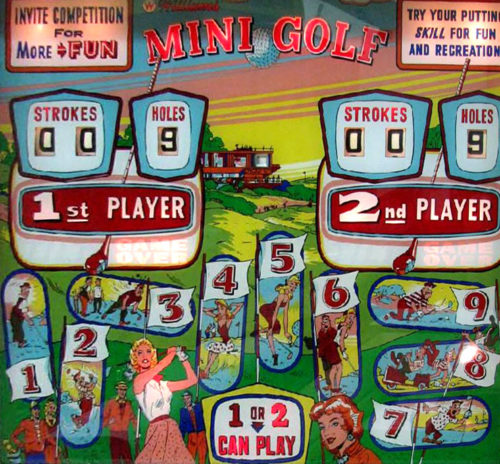 This electromechanical two-player game was designed by Steve Kordek. The game reminds one of an older game, as an animated golfer is on board that you aim to hopefully sink a ball in the appropriate hole. The nine scattered holes are tough to sink, especially the back ones. The lower your score in strokes, the better with this game (no handicap is given). Free games may be awarded set by the operator for low-stroke counts after completing so many holes. A neat and rare game.
This electromechanical two-player game was designed by Steve Kordek. The game reminds one of an older game, as an animated golfer is on board that you aim to hopefully sink a ball in the appropriate hole. The nine scattered holes are tough to sink, especially the back ones. The lower your score in strokes, the better with this game (no handicap is given). Free games may be awarded set by the operator for low-stroke counts after completing so many holes. A neat and rare game. -
 There are 7 Doctors, as one can plainly see from the backglass… quite conveniently, they are numbered 1-7. Each Doctor has the effect of changing the rules of one area of the Playfield, making a list of the rules all the more annoying and probably confusing. First some general information about the Doctors… there are many ways to “spot” doctors throughout the game – one is awarded at the start of any ball, and can be spotted through the Transmat target or Video Mode. At the start of a ball (or when a ball has been locked), you get to choose the “current” doctor – his picture will flash on the backglass. When a doctor- spotting shot is made, the current doctor will become solidly lit (so his attributes are carried over for the rest of the game), and the “current” doctor becomes the previously unlit doctor directly to the left of the previous one. There are 2 ways to spot all seven doctors – either go through them all one-by-one, or shoot the Emperor Daleks jackpot. Either way, all of them will be lit for the rest of the game, and you receive an additional bonus of 2OM, as well as a small animation, which plays even after a tilt! After all 7 doctors are spotted, they can be spotted a second (third, etc) time, and running through all 7 a second time awards another 2OM bonus. Also, each doctor spotted in the game (this count may be more than 7) is worth a 1M bonus at the end of the last ball (so don’t tilt it!), and this bonus (unlike the regular bonus) is multiplied by the Playfield X.
There are 7 Doctors, as one can plainly see from the backglass… quite conveniently, they are numbered 1-7. Each Doctor has the effect of changing the rules of one area of the Playfield, making a list of the rules all the more annoying and probably confusing. First some general information about the Doctors… there are many ways to “spot” doctors throughout the game – one is awarded at the start of any ball, and can be spotted through the Transmat target or Video Mode. At the start of a ball (or when a ball has been locked), you get to choose the “current” doctor – his picture will flash on the backglass. When a doctor- spotting shot is made, the current doctor will become solidly lit (so his attributes are carried over for the rest of the game), and the “current” doctor becomes the previously unlit doctor directly to the left of the previous one. There are 2 ways to spot all seven doctors – either go through them all one-by-one, or shoot the Emperor Daleks jackpot. Either way, all of them will be lit for the rest of the game, and you receive an additional bonus of 2OM, as well as a small animation, which plays even after a tilt! After all 7 doctors are spotted, they can be spotted a second (third, etc) time, and running through all 7 a second time awards another 2OM bonus. Also, each doctor spotted in the game (this count may be more than 7) is worth a 1M bonus at the end of the last ball (so don’t tilt it!), and this bonus (unlike the regular bonus) is multiplied by the Playfield X.